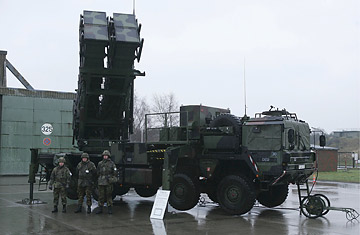
A Patriot anti-missile launcher in Wittmundhafen, Germany.
That the new U.S. intelligence assessment of Iran's nuclear program has put the kibosh on hawkish calls for a military response has been discussed to death, but there's been very little focus on a second potential casualty: the U.S. plan to base ground-based missile defenses in Poland and the Czech Republic. The plan to station interceptor missiles in Poland and tracking radars in the Czech Republic is regarded warily by citizens of those countries, and with outright hostility by the Russians who see it as aimed at blunting their own missile capability in the event of a showdown with the U.S. The plan has helped freeze U.S.-Russia ties to Cold War levels of enmity, with President Vladimir Putin just last week suspending Russia's participation in 1990s Conventional Forces in Europe treaty.
Against the barrage of criticism from the Russians, Pentagon officials have always insisted that the purpose of the missile-defense system is to protect Europe and the U.S. from an Iranian missile attack. "It's not the Russians that we're worried about," Air Force Lieutenant General Henry "Trey" Obering, chief of the Pentagon's Missile Defense Agency, said over breakfast earlier this year. "It is the Iranian missiles that we're worried about." But if the best those missiles could carry is conventional explosives, the case for deploying the missile defense system in the face of the heavy diplomatic cost and financial burden ($4 billion through 2013) becomes increasingly dubious. For one thing, the Pentagon faces mounting bills of tens of billions of dollars to "reset" the U.S. military — replacing everything worn out in Afghanistan and Iraq — over the coming decade.
But the official Pentagon line in the wake of the National Intelligence Estimate conclusion that Iran presents no imminent nuclear missile danger is that Iran's missiles are a danger, regardless of what they carry in their warheads. "Nothing has changed at all," Rick Lehner, the Pentagon's chief missile-defense spokesman, said Wednesday. "There has been no impact to our plans for a European deployment, because our missile-defense program is not geared to any kind of specific defense against a specific weapon." It all gets back to "delivery systems," as military geeks call missiles. "It's a defense against ballistic missiles, which can carry a variety of weapons," Lehner explains. "Chemical, biological, high-explosive, and nuclear, of course."
But other U.S. officials acknowledge that the reversal in the NIE on Iran makes the challenge of selling the European piece of the U.S. missile shield, which expands on already existing missile-defense sites in Alaska and California, even tougher. The threat of the "mullahs' nukes" has been the mainstay of the case made by U.S. officials to justify the European missile-defense deployment. "Iran is pursuing the technology that could be used to produce nuclear weapons and ballistic missiles of increasing range that could deliver them," President Bush told a military audience October 23. "Today we have no way to defend Europe against the emerging Iranian threat, and so we must deploy a missile defense system there that can."
But aficionados of warfare know that only nuclear weapons are true weapons of mass destruction. Chemical and biological weapons, even when delivered by missiles, are more effective at spreading terror than death and destruction. And a missile crammed with high explosives is little more than a flying car bomb — and not nearly as accurate. U.S. officials may struggle to convince skeptics that the threat they pose justify the costs, in all senses, of a missile shield.
